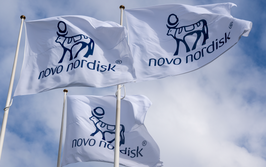
Towards More Resilient Supply
Supply chain lessons have been learned since COVID-19, so why are we seeing so many drug shortages? We speak with Noelle Lee, Vice President, Global Procurement and Drug Substance Supply Chain, pharma services, Thermo Fisher Scientific, about the challenges that supply chains face today and what the industry needs to do about it.
| 5 min read
How did the COVID-19 pandemic change attitudes towards supply chains?
The pandemic cast a huge spotlight on inefficiencies and ineffectiveness within end-to-end supply chain ecosystems. Common challenges were revealed, such as single or limited sources of supply, lack of automation and robust processes for managing volatility in demand and supply volumes, and lack of visibility and transparency across supply chain network interdependencies beyond tier-1 suppliers. In that moment, problem-solving was reactionary, but the experience proved to be a wake-up call for many companies.
Thermo Fisher Scientific played a crucial role in the global scale-up for the manufacturing and supply of COVID-19 swab test kits, qPCR instruments, and mRNA vaccines. At the height of the pandemic, we played an active role in many supply chain pivots, addressing issues related to raw material shortages, the challenges of hiring and keeping skilled workers to maintain production lines, and the geographic and logistical difficulties of transporting goods across borders, with many countries in lockdown.
To stay agile going forward, it is essential to drive deeper into understanding of “must-have” versus “nice-to-have” business requirements when developing and implementing optimal category and sourcing strategies. The industry must keep adopting new work methods, including right-sizing and localizing the supply base, using automation and analytics to identify and manage risks, and securing multiple sources for constrained supplies.
More seamless collaborations with suppliers, sharing of longer-term demand forecasting plans and investing in potential capacity reservations will also give more transparency and visibility into supply chain interdependencies in the extended ecosystem.
Despite new countermeasures, drug shortages are now a common problem. What are the challenges in supply chains today?
Since the pandemic began, many companies have implemented enterprise supply chain risk management countermeasures to mitigate disruptions. These include diversifying supplier bases, strengthening supplier relationships, increasing inventory levels, adopting remote work and digital solutions, enhancing supply chain visibility, collaborating with partners and competitors, and implementing health and safety protocols.
However, due to raw materials constraints and prioritization for COVID-19 related products during the pandemic, a number of drugs deemed as life enhancing were deprioritized over those that were considered lifesaving in the allocation of materials across supply ecosystems. As such, many of these previously deprioritized drugs are just now coming online for production.
Additionally, while most companies appreciate the need to bolster their supply chain networks, this requires significant investment.
How is turmoil in the Red Sea affecting supply chains?
The recent example of the Red Sea’s impact on supply chain demonstrates exactly the types of risks or crises companies are striving to anticipate and proactively address. Conflict in Yemen has resulted in several supply chain challenges, such as the closure of major ports, increased piracy activity, and heightened security risks for vessels navigating through the area. These disruptions have caused delays, increased transportation costs, and introduced uncertainties in supply chain planning.
To mitigate these disruptions, businesses will need to closely monitor the situation in the Red Sea region, develop and maintain relationships with alternative suppliers and logistics partners, and have contingency plans in place. This may involve diversifying transportation routes, exploring alternative ports, or utilizing air freight options when necessary.
What more can companies do?
Companies should take a holistic, proactive approach to supply chain risk management. They should conduct thorough risk assessments to identify vulnerabilities and develop strategies to mitigate risks. Building strong relationships with suppliers and regularly assessing their capabilities and compliance are crucial. Enhancing supply chain visibility through technology and risk data analytics helps with tracking and optimizing supply chain operations. Developing robust business continuity plans and collaborating with industry peers and stakeholders also contributes to supply chain security. Additionally, companies can enhance supply chain resilience and ensure a reliable flow of goods and services by prioritizing the implementation of advanced cybersecurity measures and ensuring sustainability and ethical standards in the supply chain.
What are your top “dos” and “don’ts” for reviewing and managing supply chains?
Dos:
- Identify key business requirement needs associated with Assurance of supply, Quality, Service, Cost, Innovation, Regulatory and Sustainability (AQSCIR) criteria. Determine must-have versus nice-to-have business requirements for both short-term and long-term horizons. Then, develop category and sourcing strategies that meet these.
- Conduct regular enterprise supply chain risk assessments and thorough reviews of your supply chain. Identify areas for improvement and implement necessary changes.
- Establish strong relationships and transparent communication with suppliers, stakeholders, and internal teams. This promotes collaboration, problem-solving, and effective decision-making.
- Develop multi-sources of supplier base to mitigate sole and single-source risks, ensure continuity, and maintain agility in the supply chain.
- Invest in technology and data analytics to enhance supply chain visibility across the extended supply ecosystem, gain insights, optimize operations, and make informed decisions.
- Incorporate sustainability and ethical practice considerations into supply chain management. This includes responsible sourcing, reducing environmental impact, and ensuring fair labor practices.
Don'ts:
- Avoid focusing risk-management scope on top-spend suppliers. Determining the segmentation of risk criticality is dependent on the nature of each company’s individual business. At times, the smallest spend supplier – even a bolt or nut, in the example of an aerospace product – could lead to severe impacts if not managed appropriately.
- Supplier selection decisions should not be based purely on cost. Understand total cost of ownership and the trade-offs against various key business requirements.
- Avoid situations of not providing demand forecasting plans to key suppliers. Strong and collaborative relationships with suppliers are crucial to ensuring you are getting the service, reliability, quality, and responsiveness in the supply chain that you need.
This is not an exhaustive list, but by taking these actions, you can review and manage your supply chain effectively, enhance performance, mitigate risks, and drive long-term success.
Overall, the frequency of supply chain disruptions highlights the need for proactive risk management strategies, effective communication, and adaptability in the face of geopolitical issues, conflicts and natural disasters. It is important to remain agile as supply chains are dynamic and constantly evolving. By investing in robust processes or technologies, we can continuously adapt, innovate and embrace change to stay competitive and resilient.



















